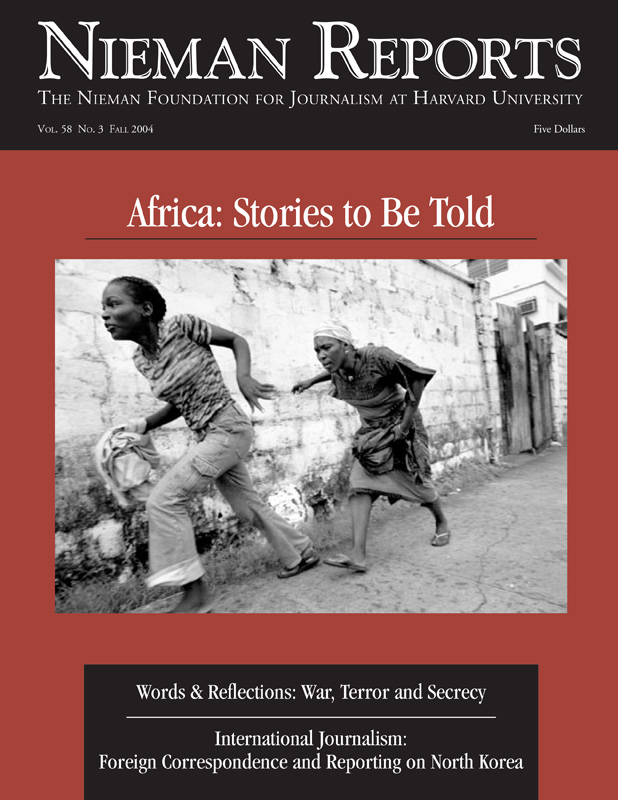My first experience of life in Africa came moments after the plane landed in Nairobi in an early morning fog. Sitting in a black London-style taxi as it dodged potholes, we passed a Masai herder in his traditional red robe. His face was pressed against a fence near the airport. As we headed downtown, we saw thousands of men and women walking on unpaved paths. This was the morning commute. Many of them were walking 15 miles to their jobs or in search of work, and they’d make the same journey home. Walking instead of taking the minibus saved them 12 cents. For many, that was enough to eat or pay their children’s school fees.
My first impression of these trudging Kenyans remained with me after my wife, Abby, and I moved to Nairobi with our two small children. About a year into this foreign posting, I proposed a story about how Africans live on less than one dollar a day. Los Angeles Times foreign editor, Marjorie Miller, suggested this story idea be transformed into a series. And so began my journalistic exploration into poor Africans’ daily struggles. As I worked to tell these stories to readers, my family also became embroiled in a fight for survival, and these parallel tracks I traveled lent me a special awareness that my reporting, by itself, could not.
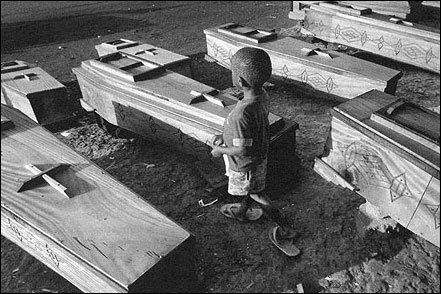
A child plays around caskets being sold by the roadside in Masaka, Uganda. One casket costs about $20. Casket makers earn more than those living in rural villages, as the high number of people with HIV/AIDS makes this a profitable business. Photo by Francine Orr/Los Angeles Times.
Getting Behind the Statistics
Aid agencies—and reporters—often trot out measures of extreme poverty to describe a country or region’s economy and account for its underdevelopment. The number of people living on less than one dollar a day is one of the more common statistics used. While in many countries some people have no choice but to find ways to survive on a meager income, Africa is the only continent where the proportion of people living in such extreme poverty is increasing. The World Bank estimates that 49 percent of people in sub-Saharan Africa must make do with less than one dollar a day.
The project I proposed was an attempt to pull away the statistical curtain and reveal a close-up view of how these Africans go about their daily lives. We would work to capture and convey the human dignity not often found in stories painting statistical portraits. We certainly did not want to romanticize poverty or portray Africans as one-dimensional objects of pity. As things turned out, we encountered stories of an Africa that is sometimes brutal and dramatic, often painful, but also jubilant.
After a volley of memos with Miller and my editor, Mark Porubcansky, we decided to aim for a series of articles detailing how—with less than one dollar a day—Africans feed, clothe, shelter, educate and acquire health care for themselves and their children. Staff photographer Francine Orr, based in Los Angeles, was assigned to join me.
Our first story would be about work. How did people earn the money they lived on? To tell this story, I set out for a place I knew from earlier reporting could accurately illustrate the struggle just to find work—Goma, Democratic Republic of the Congo (DRC). Several months earlier, I’d been to Eastern DRC to report on the eruption of Mt. Nyiragongo, a volcano that looms eerily over Goma. Nearly half the town was entombed by the volcano, yet people went about their daily routine, trudging to work. When I stopped people in the street to ask them how the volcano was affecting their livelihoods and how they were going to live after the disaster, more than once the interviewee shrugged and answered: “Je ne sais pas. Se débrouiller.”
“Se débrouiller” is French for eking out a living out of nothing, and soon I discovered that Goma was a town of débrouillards. People rose early in the morning to perform menial labor or peddle food and goods in the streets. Government workers routinely reported to work even though they were never paid. “Having a job that doesn’t pay is better than having no job at all,” the director of the government’s division of work told me.
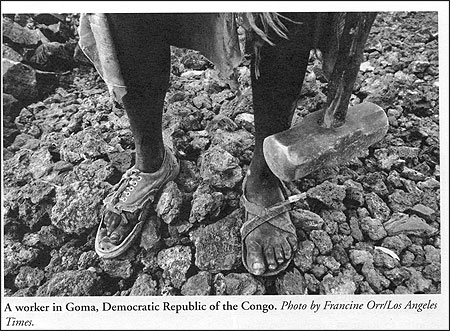
A worker in Boma, Democratic Republic of the Congo.
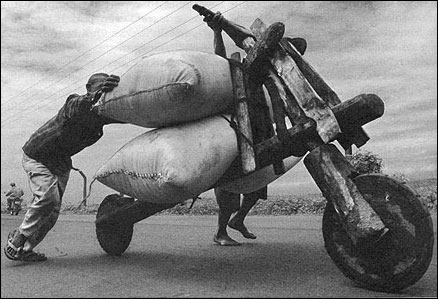
Homemade wooden scooters called chukudus are used for transportation and carrying goods around Goma. Photos by Francine Orr/Los Angeles Times.
After the Congo, Francine and I traveled to Nigeria where we hoped to report on clothes and how global economics is altering centuries-old equations in Africa. It had taken me six months to secure a journalist visa but, thanks to contacts I’d made during that quest, Orr’s visa was approved in two days. Here we’d show how used clothes imported from the West are replacing Africa’s flamboyant fabrics and closing hundreds of factories. We also wanted to capture Nigerian ingenuity that surmounts the government’s ban on used clothing. To do so, we chose Yaba market on the outskirts of Lagos, the largest city in sub-Saharan Africa.
After taking a brief break to report a Page One story about religious riots that broke out during the Miss World pageant, we spent a few days navigating Yaba market, trying to capture its vibe. I recorded how the prize item on a vendor’s rack was the bomber jacket worn by Tiffany of Costa Mesa High School, a school in our circulation area. Donated clothes from California ending up in such markets in Africa made me feel that the world of our readers was indissolubly chained to these people in this Nigerian market. But these acts of charity were much more than that: Each has its ripple effect, creating livelihoods for many and killing the jobs of others, and it became our job to show how this works and the affect it has on African families.
To engage readers fully, we had to approach our reporting in the Nigerian way. Before interviewing vendors, we followed a local reporter’s advice and visited the head of the vendors’ association. At noon, we joined the drum circle, when the vendors and their customers took a break from the ferocious African sun. We were no longer strangers.
We also traveled to southern Africa where a drought, poor public policy, and AIDS were causing hunger. Though we’d planned to go to parts of rural Zambia to report on people eating roots, leaves, even poison berries to try to survive, we found another compelling story in the country’s capital city, Lusaka, where residents scraped together pennies to buy food. I filled notebooks with stories from families living in the shanties in Lusaka’s so-called Garden District. And despite starvation of many of its people, Zambia refused to accept U.S. produced genetically modified foods.
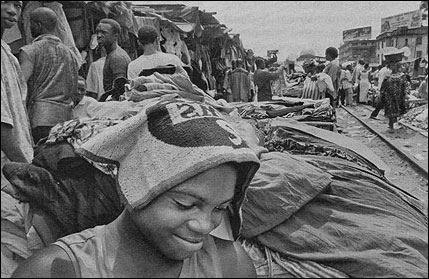
A young merchant sits next to piles of used clothing under the hot sun at the Yaba Market in Lagos, Nigeria. Clothing merchants sell used clothing illegally imported from the United States.
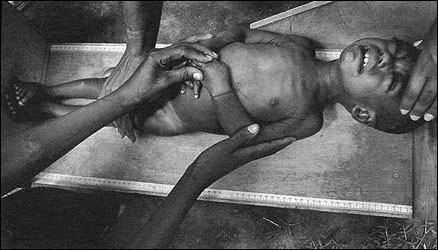
Health workers measure a one and a half-year-old boy's height during a medical evaluation at the Yirba Therapeautic Feeding Center in southern Ethiopia. He is malnourished and, like other children there, is highly susceptible to skin infection, pneumonia and malaria.

Children run barefoot through houses that have holes in the walls in Nairobi, Kenya. Sounds of children laughing and crying and the smel of human excrement and cooking fill the air. Photos by Francine Orr/Los Angeles Times.
Personal Struggles Intervene
The day before Francine and I were to make our trip to the countryside outside Lusaka, the call came. Back in Nairobi, my wife, Abby, was being checked into the hospital. Her liver enzyme numbers were soaring at an alarming rate, and doctors were worried. Both Abby and I thought this was a simple case of curable hepatitis and that she’d beat it with the help of the doctors at the well-regarded Aga Khan Hospital in Nairobi. As Francine headed for southern Zambia, I headed straight to the hospital. Abby was not in good shape. Her skin and eyeballs had turned topaz yellow.
Doctors later surmised that drugs prescribed to fend off mighty African amoebas were killing her liver. For the next three weeks, as Abby’s condition worsened, we were moved from the Aga Khan to the best liver transplant hospital in London. We took only a backpack, confident that we would return in a few days. A friend agreed to stay with our children, Armaan, then four, and Maya, two.
“I’m humbled,” Abby told me after the mainly African medical staff left her room at King’s College Hospital in London. “If I were an African without means, I’d be dead.” The doctors in London then suggested we move Abby to Los Angeles because her O+ blood type did not make her a promising candidate for getting a transplant in Europe. In Los Angeles, we were met by paramedics waiting for us with a gurney.
From Abby’s University of California at Los Angeles (UCLA) hospital room, and with help from a stringer, I filed a front-page story about Daniel Arap Moi’s ruling Kenya African National Union party being ousted from power after four decades of one-party rule. Our colleagues and friends in Nairobi were ecstatic as Kenya was caught up in a spirit of euphoria and rebirth. But for us, these were tough times. Abby’s numbers continued to worsen. On January 8, 2004, she was wheeled into the operating room, given a new liver and a fresh lease on life.
We spent the next four months in a hotel room footsteps from UCLA hospital, joined by our children, who’d been brought there by my sister, who called off her vacation in Italy and traveled to Africa to take them from the care of our friends. I kept in touch with sources and local staff in Africa, and after Abby was well enough, I returned to Africa to finish my reporting on this project.
Returning to Africa
Correspondents who choose to go to Africa believe that they can make a difference by telling the stories from this largely forgotten continent. Often, I find, they also bear much guilt. While reporting on poverty and conflict, they stay in the continent’s finest hotels. They know their airfare to any destination could feed those who live in a small village or alleviate some of the needs they write about. Expatriate homes have multiple bathrooms, while not far away slum dwellers use plastic bags and hurl them like slingshots away from the scene of the crime.
I carried much of this guilt, and when I returned to finish reporting these stories in Africa I brought along with me a deeper sense of compassion for the people whose life stories I was borrowing to bring to readers. As Abby had observed early on in her health crisis and I knew, the tens of thousands of dollars that had gone into keeping her alive could have saved hundreds of lives in Africa.
Logistically, too, due to Abby’s illness, Francine’s and my reporting schedules were now different, and we traveled separately: Some of our trips were made months apart. Even so, it was often as if time had stood still. In a trip I’d made to South Africa, I met three children who had to drop out of the school located next to their house because their mother couldn’t afford the $10 annual school fee. (Their father had abandoned the family years before.) When Francine went there several months later, these children were in the same predicament—penniless and dependent on their neighbors for a plate of plain rice. As we approached publication, I kept in touch with the school’s principal by phone from Los Angeles to see if anything had changed. It hadn’t.
While the food crises in Zambia and elsewhere in Southern Africa subsided somewhat after our visits there, a similar disaster festered in Ethiopia. Members of an Ethiopian family I interviewed four months earlier wore the same clothes—their only set—when Francine showed up six months later. Finding them each time was not easy. Francine made two trips to the remote region in southern Ethiopia before she was able to locate them to take photographs.
And Kassim Issa, an AIDS patient whom I had followed for several months, was still alive when Francine visited him. He was among the lucky Africans to receive antiretroviral drugs. Issa survived despite his poverty and dagger-like missives from his mother-in-law who was upset that he had given her late daughter the disease, then saddled her with their two children. We never met his mother-in-law, but her colorful letters were featured prominently in our story.
‘Living on Pennies’
Our “Living On Pennies” six-part series ran across a total of 20 pages in July. The stories were relatively short, with each one ranging from 2,200 to 2,800 words. Expert comment and background were limited so the story could focus tightly on Africans going about their everyday lives. With deliberate intent, Francine’s pictures were printed in black and white so that the vibrant color did not detract from the essence of the images.
We’ve since received more than 600 letters and e-mails. (The readers’ comments became the series’ epilogue and, on the Web site, I responded by video to their comments and reactions.) Francine and I were both struck by the large number of responses we received from people who read our newspaper’s Web edition of this series and saw accompanying images. Readers in Canada, India, Japan and Germany were among those who thanked the editors for devoting the space to give them an inside glimpse into the lives of these African people. Like our U.S. readers, many sent checks to aid groups listed on the paper’s Web site.
Just as donated used clothing connects people across the world, our newspaper is no longer a local form of communication. Readers from across the globe said that they were eager to read our next installments. Many readers asked Francine and me how the series changed us and the way we look at life. Despite all the talk about compassion fatigue, I came away from this reporting experience with a sense that people do care about the plight of others when they connect with stories of human beings engaged in the struggle for survival.
This assignment also reinforced my admiration for the indomitable African spirit. Long before the idea of doing this project entered my mind, I asked a colleague how Africans lived on less than one dollar a day. “Davan, they don’t,” he said bluntly.
At the end of my reporting, I realized that he was right. The people we interviewed were winners simply because they survived to go on to the next day and struggle again. Their victories were small, and every day they had to fight the same battles.
Davan Maharaj is an assistant foreign editor with the Los Angeles Times. He was the Nairobi bureau chief from 2001-2003. The “Living on Pennies” series of articles can be found at www.latimes.com/news/printedition/la-fg-work11jul11,0,3038986.story.
My first impression of these trudging Kenyans remained with me after my wife, Abby, and I moved to Nairobi with our two small children. About a year into this foreign posting, I proposed a story about how Africans live on less than one dollar a day. Los Angeles Times foreign editor, Marjorie Miller, suggested this story idea be transformed into a series. And so began my journalistic exploration into poor Africans’ daily struggles. As I worked to tell these stories to readers, my family also became embroiled in a fight for survival, and these parallel tracks I traveled lent me a special awareness that my reporting, by itself, could not.

A child plays around caskets being sold by the roadside in Masaka, Uganda. One casket costs about $20. Casket makers earn more than those living in rural villages, as the high number of people with HIV/AIDS makes this a profitable business. Photo by Francine Orr/Los Angeles Times.
Getting Behind the Statistics
Aid agencies—and reporters—often trot out measures of extreme poverty to describe a country or region’s economy and account for its underdevelopment. The number of people living on less than one dollar a day is one of the more common statistics used. While in many countries some people have no choice but to find ways to survive on a meager income, Africa is the only continent where the proportion of people living in such extreme poverty is increasing. The World Bank estimates that 49 percent of people in sub-Saharan Africa must make do with less than one dollar a day.
The project I proposed was an attempt to pull away the statistical curtain and reveal a close-up view of how these Africans go about their daily lives. We would work to capture and convey the human dignity not often found in stories painting statistical portraits. We certainly did not want to romanticize poverty or portray Africans as one-dimensional objects of pity. As things turned out, we encountered stories of an Africa that is sometimes brutal and dramatic, often painful, but also jubilant.
After a volley of memos with Miller and my editor, Mark Porubcansky, we decided to aim for a series of articles detailing how—with less than one dollar a day—Africans feed, clothe, shelter, educate and acquire health care for themselves and their children. Staff photographer Francine Orr, based in Los Angeles, was assigned to join me.
Our first story would be about work. How did people earn the money they lived on? To tell this story, I set out for a place I knew from earlier reporting could accurately illustrate the struggle just to find work—Goma, Democratic Republic of the Congo (DRC). Several months earlier, I’d been to Eastern DRC to report on the eruption of Mt. Nyiragongo, a volcano that looms eerily over Goma. Nearly half the town was entombed by the volcano, yet people went about their daily routine, trudging to work. When I stopped people in the street to ask them how the volcano was affecting their livelihoods and how they were going to live after the disaster, more than once the interviewee shrugged and answered: “Je ne sais pas. Se débrouiller.”
“Se débrouiller” is French for eking out a living out of nothing, and soon I discovered that Goma was a town of débrouillards. People rose early in the morning to perform menial labor or peddle food and goods in the streets. Government workers routinely reported to work even though they were never paid. “Having a job that doesn’t pay is better than having no job at all,” the director of the government’s division of work told me.

A worker in Boma, Democratic Republic of the Congo.

Homemade wooden scooters called chukudus are used for transportation and carrying goods around Goma. Photos by Francine Orr/Los Angeles Times.
After the Congo, Francine and I traveled to Nigeria where we hoped to report on clothes and how global economics is altering centuries-old equations in Africa. It had taken me six months to secure a journalist visa but, thanks to contacts I’d made during that quest, Orr’s visa was approved in two days. Here we’d show how used clothes imported from the West are replacing Africa’s flamboyant fabrics and closing hundreds of factories. We also wanted to capture Nigerian ingenuity that surmounts the government’s ban on used clothing. To do so, we chose Yaba market on the outskirts of Lagos, the largest city in sub-Saharan Africa.
After taking a brief break to report a Page One story about religious riots that broke out during the Miss World pageant, we spent a few days navigating Yaba market, trying to capture its vibe. I recorded how the prize item on a vendor’s rack was the bomber jacket worn by Tiffany of Costa Mesa High School, a school in our circulation area. Donated clothes from California ending up in such markets in Africa made me feel that the world of our readers was indissolubly chained to these people in this Nigerian market. But these acts of charity were much more than that: Each has its ripple effect, creating livelihoods for many and killing the jobs of others, and it became our job to show how this works and the affect it has on African families.
To engage readers fully, we had to approach our reporting in the Nigerian way. Before interviewing vendors, we followed a local reporter’s advice and visited the head of the vendors’ association. At noon, we joined the drum circle, when the vendors and their customers took a break from the ferocious African sun. We were no longer strangers.
We also traveled to southern Africa where a drought, poor public policy, and AIDS were causing hunger. Though we’d planned to go to parts of rural Zambia to report on people eating roots, leaves, even poison berries to try to survive, we found another compelling story in the country’s capital city, Lusaka, where residents scraped together pennies to buy food. I filled notebooks with stories from families living in the shanties in Lusaka’s so-called Garden District. And despite starvation of many of its people, Zambia refused to accept U.S. produced genetically modified foods.

A young merchant sits next to piles of used clothing under the hot sun at the Yaba Market in Lagos, Nigeria. Clothing merchants sell used clothing illegally imported from the United States.

Health workers measure a one and a half-year-old boy's height during a medical evaluation at the Yirba Therapeautic Feeding Center in southern Ethiopia. He is malnourished and, like other children there, is highly susceptible to skin infection, pneumonia and malaria.

Children run barefoot through houses that have holes in the walls in Nairobi, Kenya. Sounds of children laughing and crying and the smel of human excrement and cooking fill the air. Photos by Francine Orr/Los Angeles Times.
Personal Struggles Intervene
The day before Francine and I were to make our trip to the countryside outside Lusaka, the call came. Back in Nairobi, my wife, Abby, was being checked into the hospital. Her liver enzyme numbers were soaring at an alarming rate, and doctors were worried. Both Abby and I thought this was a simple case of curable hepatitis and that she’d beat it with the help of the doctors at the well-regarded Aga Khan Hospital in Nairobi. As Francine headed for southern Zambia, I headed straight to the hospital. Abby was not in good shape. Her skin and eyeballs had turned topaz yellow.
Doctors later surmised that drugs prescribed to fend off mighty African amoebas were killing her liver. For the next three weeks, as Abby’s condition worsened, we were moved from the Aga Khan to the best liver transplant hospital in London. We took only a backpack, confident that we would return in a few days. A friend agreed to stay with our children, Armaan, then four, and Maya, two.
“I’m humbled,” Abby told me after the mainly African medical staff left her room at King’s College Hospital in London. “If I were an African without means, I’d be dead.” The doctors in London then suggested we move Abby to Los Angeles because her O+ blood type did not make her a promising candidate for getting a transplant in Europe. In Los Angeles, we were met by paramedics waiting for us with a gurney.
From Abby’s University of California at Los Angeles (UCLA) hospital room, and with help from a stringer, I filed a front-page story about Daniel Arap Moi’s ruling Kenya African National Union party being ousted from power after four decades of one-party rule. Our colleagues and friends in Nairobi were ecstatic as Kenya was caught up in a spirit of euphoria and rebirth. But for us, these were tough times. Abby’s numbers continued to worsen. On January 8, 2004, she was wheeled into the operating room, given a new liver and a fresh lease on life.
We spent the next four months in a hotel room footsteps from UCLA hospital, joined by our children, who’d been brought there by my sister, who called off her vacation in Italy and traveled to Africa to take them from the care of our friends. I kept in touch with sources and local staff in Africa, and after Abby was well enough, I returned to Africa to finish my reporting on this project.
Returning to Africa
Correspondents who choose to go to Africa believe that they can make a difference by telling the stories from this largely forgotten continent. Often, I find, they also bear much guilt. While reporting on poverty and conflict, they stay in the continent’s finest hotels. They know their airfare to any destination could feed those who live in a small village or alleviate some of the needs they write about. Expatriate homes have multiple bathrooms, while not far away slum dwellers use plastic bags and hurl them like slingshots away from the scene of the crime.
I carried much of this guilt, and when I returned to finish reporting these stories in Africa I brought along with me a deeper sense of compassion for the people whose life stories I was borrowing to bring to readers. As Abby had observed early on in her health crisis and I knew, the tens of thousands of dollars that had gone into keeping her alive could have saved hundreds of lives in Africa.
Logistically, too, due to Abby’s illness, Francine’s and my reporting schedules were now different, and we traveled separately: Some of our trips were made months apart. Even so, it was often as if time had stood still. In a trip I’d made to South Africa, I met three children who had to drop out of the school located next to their house because their mother couldn’t afford the $10 annual school fee. (Their father had abandoned the family years before.) When Francine went there several months later, these children were in the same predicament—penniless and dependent on their neighbors for a plate of plain rice. As we approached publication, I kept in touch with the school’s principal by phone from Los Angeles to see if anything had changed. It hadn’t.
While the food crises in Zambia and elsewhere in Southern Africa subsided somewhat after our visits there, a similar disaster festered in Ethiopia. Members of an Ethiopian family I interviewed four months earlier wore the same clothes—their only set—when Francine showed up six months later. Finding them each time was not easy. Francine made two trips to the remote region in southern Ethiopia before she was able to locate them to take photographs.
And Kassim Issa, an AIDS patient whom I had followed for several months, was still alive when Francine visited him. He was among the lucky Africans to receive antiretroviral drugs. Issa survived despite his poverty and dagger-like missives from his mother-in-law who was upset that he had given her late daughter the disease, then saddled her with their two children. We never met his mother-in-law, but her colorful letters were featured prominently in our story.
‘Living on Pennies’
Our “Living On Pennies” six-part series ran across a total of 20 pages in July. The stories were relatively short, with each one ranging from 2,200 to 2,800 words. Expert comment and background were limited so the story could focus tightly on Africans going about their everyday lives. With deliberate intent, Francine’s pictures were printed in black and white so that the vibrant color did not detract from the essence of the images.
We’ve since received more than 600 letters and e-mails. (The readers’ comments became the series’ epilogue and, on the Web site, I responded by video to their comments and reactions.) Francine and I were both struck by the large number of responses we received from people who read our newspaper’s Web edition of this series and saw accompanying images. Readers in Canada, India, Japan and Germany were among those who thanked the editors for devoting the space to give them an inside glimpse into the lives of these African people. Like our U.S. readers, many sent checks to aid groups listed on the paper’s Web site.
Just as donated used clothing connects people across the world, our newspaper is no longer a local form of communication. Readers from across the globe said that they were eager to read our next installments. Many readers asked Francine and me how the series changed us and the way we look at life. Despite all the talk about compassion fatigue, I came away from this reporting experience with a sense that people do care about the plight of others when they connect with stories of human beings engaged in the struggle for survival.
This assignment also reinforced my admiration for the indomitable African spirit. Long before the idea of doing this project entered my mind, I asked a colleague how Africans lived on less than one dollar a day. “Davan, they don’t,” he said bluntly.
At the end of my reporting, I realized that he was right. The people we interviewed were winners simply because they survived to go on to the next day and struggle again. Their victories were small, and every day they had to fight the same battles.
Davan Maharaj is an assistant foreign editor with the Los Angeles Times. He was the Nairobi bureau chief from 2001-2003. The “Living on Pennies” series of articles can be found at www.latimes.com/news/printedition/la-fg-work11jul11,0,3038986.story.
